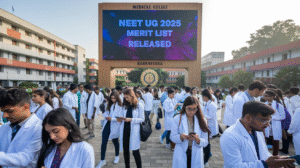Have you ever found yourself dreaming of a medical career, only to face the disappointment of missing out on regular MBBS admissions? 😔 Don’t lose hope just yet! MBBS Spot Admission might be the golden ticket you’ve been waiting for. 🎟️
We understand the stress and uncertainty that comes with pursuing a medical education. That’s why we’re here to shed light on this lesser-known pathway to your dreams. Spot admissions offer a last-minute chance for aspiring doctors who missed the regular admission rounds. With lower cut-offs and an expedited process, it’s an opportunity that could change your life. 🌟
In this post, we’ll dive deep into the world of MBBS Spot Admissions. We’ll explore everything from the application process and essential documents to the advantages and challenges you might face. Whether you’re considering this route or just curious about your options, we’ve got you covered. Let’s unravel the mystery of spot admissions together and discover if it’s the right path for you!
Understanding MBBS Spot Admission

A. Definition and purpose
MBBS spot admission is a process that occurs after the regular admission rounds for medical colleges have concluded. It provides a final opportunity for aspiring medical students to secure a seat in an MBBS program. The primary purpose of spot admissions is to fill any remaining vacant seats in medical institutions after the initial allocation process.
B. Timing in the admission cycle
We typically see spot admissions taking place towards the end of the admission cycle. Here’s a general timeline:
- Regular admissions: June to September
- Seat allocation: October-November
- Spot admissions: November to December
This timing allows for the completion of regular admission procedures before opening up the spot admission process.
C. Eligibility criteria
To be eligible for MBBS spot admission, candidates must meet specific requirements:
| Eligibility Criteria | Details |
|---|---|
| Entrance Exam | Must have taken the relevant medical entrance exam |
| Previous Allocation | Should not have been allocated a seat in the regular process |
| Educational Qualification | Completed 10+2 with required subjects |
Additionally, candidates need to be prepared with essential documents, including:
- Entrance exam scorecards
- Academic marksheets
- Identity proof
It’s important to note that some institutions may apply reservation policies, allocating specific percentages of seats for categories such as SC, ST, OBC, and EWS.
Now that we have covered the fundamentals of MBBS spot admission, including its definition, timing, and eligibility criteria, we’ll move on to explore the intricacies of the spot admission process itself. In the next section, we’ll delve into the step-by-step procedure that candidates need to follow to participate in this last-minute opportunity for securing a seat in a medical college.
The Spot Admission Process
Now that we’ve covered the basics of MBBS spot admission, let’s delve into the step-by-step process. The spot admission procedure is a structured approach that offers a final opportunity for aspiring medical students to secure a seat in their desired institution.
A. Notification of vacant seats
We typically see spot admissions for MBBS taking place after the regular admission rounds conclude. The process usually unfolds from November to December, following the regular admissions that occur from June to September. Medical bodies responsible for admissions will notify candidates about available seats through official channels.
B. Registration and fee submission
Once notified, we guide interested candidates through the registration process. This involves:
- Meeting eligibility criteria
- Submitting the application
- Paying the required fees
It’s crucial to note that candidates must have taken the relevant medical entrance exam and not been allocated a seat in the regular process to be eligible for spot admissions.
C. Document verification
After registration, we move on to the critical step of document verification. This process ensures that all applicants meet the necessary requirements. Essential documents typically include:
| Document Type | Purpose |
|---|---|
| Entrance exam scorecards | To verify eligibility and ranking |
| Academic marksheets | To confirm educational qualifications |
| Identity proof | To validate the applicant’s identity |
D. Seat allotment and enrollment
The final stage of the spot admission process involves:
- Seat allotment based on availability and merit
- Acceptance of the allotted seat by the candidate
- Completion of enrollment procedures
We remind candidates that this stage often requires quick decision-making, as spots are limited and highly competitive.
With the spot admission process explained, we’ll next explore the essential documents required for MBBS spot admission in more detail. This information will help you prepare thoroughly for this crucial step in your medical education journey.
Essential Documents for Spot Admission

Now that we’ve covered the spot admission process, let’s delve into the essential documents you’ll need for MBBS spot admission. We’ve compiled a comprehensive list to ensure you’re well-prepared for this crucial step.
A. Entrance exam scorecards
When it comes to MBBS spot admissions, your NEET UG scorecard is paramount. We can’t stress enough how important it is to have this document ready. Here’s what you need to know:
- Ensure you have the original NEET UG 2025 scorecard
- Keep multiple photocopies of the scorecard
- The scorecard should clearly display your rank and percentile
B. Academic marksheets
Your academic performance plays a significant role in the admission process. We recommend organizing the following documents:
| Document | Details |
|---|---|
| Class 12 marksheet | Original + 2-3 attested copies |
| Class 10 marksheet | Original + 2-3 attested copies |
| Class 11 marksheet | May be required by some institutions |
Remember, these documents should be in English or Hindi. If they’re in a local language, we advise getting them translated and attested.
C. Identity proof
Proving your identity is crucial during the spot admission process. We suggest bringing the following:
- Aadhar card (preferred)
- Passport (alternative option)
- Government-issued ID (backup)
Additionally, don’t forget these essential items:
- Passport-sized photographs (at least 4-6)
- Date of birth certificate
- Character certificate
- Migration certificate (if applicable)
- Transfer certificate
- Physical fitness certificate
For those applying under specific categories, we recommend having these additional documents:
- Caste certificate (for OBC, SC, ST candidates)
- Disability certificate (for PwD candidates)
- EWS certificate (for Economically Weaker Section candidates)
NRI applicants should also prepare:
- Sponsorship affidavit
- Sponsor’s passport copy
- Relationship affidavit
With these documents in hand, we’re confident you’ll be well-prepared for the spot admission process. Next, we’ll explore the institutions offering spot admissions, giving you a clear picture of where these opportunities are available.
Institutions Offering Spot Admissions
Now that we’ve covered the essential documents required for spot admission, let’s explore the institutions that offer these opportunities.
A. Notable Indian colleges
In India, several prestigious institutions offer MBBS spot admissions. One of the most renowned among these is the All India Institute of Medical Sciences (AIIMS). We’ve observed that AIIMS, along with other notable Indian medical colleges, typically conducts spot admissions after the conclusion of regular admission rounds.
Here’s a quick overview of the spot admission process at Indian colleges:
| Process Step | Timing |
|---|---|
| Regular Admissions | June to September |
| Seat Allocation | October-November |
| Spot Admissions | November to December |
It’s important to note that the specific dates may vary depending on the region and the medical bodies conducting the admissions.
B. International institutions
While spot admissions are more common in Indian medical colleges, some international institutions also offer similar opportunities, albeit rarely. We’ve found that prestigious universities like Harvard and King’s College London occasionally have spot admission processes.
When considering international institutions, we recommend keeping the following in mind:
- Admission requirements are typically more stringent
- Financial considerations play a significant role
- English proficiency tests like TOEFL or IELTS are often required
- Research experience can enhance your application
For international spot admissions, we’ve noticed that the process may differ from Indian institutions. Here are some key points to consider:
- Higher academic requirements (e.g., GPA above 3.90 for Ivy League schools)
- Competitive entrance exam scores (e.g., MCAT score of 520+ for top-tier universities)
- Emphasis on extracurricular activities and relevant letters of recommendation
- Need for a compelling application essay
With this understanding of the institutions offering spot admissions, we’ll next explore the advantages of opting for this admission route. We’ll see how these last-minute opportunities can benefit aspiring medical students and what unique prospects they present.
Advantages of Spot Admissions
Now that we’ve explored the institutions offering spot admissions for MBBS, let’s delve into the advantages these admissions present. Spot admissions offer several benefits that can be particularly appealing to aspiring medical students.
A. Last-minute opportunity
Spot admissions provide a valuable last-minute chance for candidates who may have missed out on regular admission rounds. We understand that the regular MBBS admission process typically concludes by September, with seat allocations occurring in October-November. However, spot admissions usually take place from November to December, offering a final opportunity for those who:
- Didn’t secure a seat in the regular process
- Missed earlier application deadlines
- Are looking for alternative options
This extended timeframe can be a lifeline for students who might otherwise have to wait an entire year to pursue their medical education.
B. Expedited admission process
One of the most significant advantages of spot admissions is the accelerated process. We’ve observed that the spot admission procedure typically involves:
- Notification of vacant seats
- Registration
- Fee submission
- Application submission
- Document verification
- Seat allotment
- Final enrollment
This streamlined approach can significantly reduce the time between application and enrollment, allowing students to start their medical journey sooner.
| Regular Admissions | Spot Admissions |
|---|---|
| June to September | November to December |
| Multiple rounds | Single, swift process |
| Longer waiting periods | Rapid decisions |
C. Potentially lower cut-offs
In our experience, spot admissions may sometimes have lower cut-offs compared to regular admission rounds. This can be advantageous for students who:
- Scored slightly below the initial cut-off marks
- Performed well but missed the earlier admission cycles
- Are looking for a second chance to secure admission
However, it’s important to note that while cut-offs may be lower, competition for these limited seats can still be intense.
With these advantages in mind, we’ll next explore the challenges and considerations associated with MBBS spot admissions. It’s crucial to weigh these benefits against potential drawbacks to make an informed decision about pursuing this admission route.
Challenges and Considerations
Now that we’ve explored the advantages of spot admissions, it’s crucial to consider the challenges and potential drawbacks associated with this process. Let’s delve into the key considerations that aspiring medical students should keep in mind when pursuing MBBS spot admissions.
A. Competition for limited seats
While spot admissions offer a last-minute opportunity for candidates who missed regular admissions, the competition can be fierce. We’ve observed that:
- Vacant seats are typically limited in number
- Many qualified candidates vie for these few positions
- The rush to secure a spot can create a high-pressure environment
B. Higher fees
One of the most significant considerations for spot admissions is the potential financial burden. We’ve found that:
| Regular Admission | Spot Admission |
|---|---|
| Standard fees | Potentially higher fees |
| More time to arrange finances | Rapid financial preparation required |
| Scholarship opportunities | Limited financial aid options |
C. Rapid decision-making required
The nature of spot admissions necessitates quick thinking and action. We’ve identified several challenges in this regard:
- Limited time to research colleges thoroughly
- Pressure to make life-changing decisions quickly
- Uncertainty about college choices due to time constraints
- Need for immediate document preparation and submission
With these challenges in mind, it’s essential to be well-prepared for the spot admission process. In the next section, we’ll explore strategies for preparing effectively, ensuring you’re ready to seize the opportunity if it arises.
Preparing for Spot Admissions

Now that we’ve discussed the challenges and considerations of MBBS spot admissions, let’s focus on how to prepare effectively for this unique opportunity. Proper preparation can significantly increase your chances of securing a spot in your desired medical program.
Staying informed about notifications
We cannot stress enough the importance of staying up-to-date with spot admission notifications. Here are some key strategies:
- Regularly check official websites of medical colleges
- Follow social media accounts of educational institutions
- Subscribe to email notifications from relevant authorities
- Join online forums or groups dedicated to MBBS admissions
Researching colleges thoroughly
Before applying for spot admissions, we recommend conducting in-depth research on potential colleges. This preparation will help you make informed decisions during the admission process.
| Research Aspect | Key Points to Consider |
|---|---|
| Academic Reputation | Faculty qualifications, research output |
| Infrastructure | Labs, libraries, hostel facilities |
| Clinical Exposure | Affiliated hospitals, patient interaction opportunities |
| Placement Records | Internship opportunities, alumni success stories |
Financial readiness
We understand that financial preparation is crucial for MBBS spot admissions. Here’s what you need to consider:
- Estimate total costs, including tuition, accommodation, and living expenses
- Explore scholarship options and financial aid programs
- Prepare necessary documents for loan applications, if required
- Keep funds readily available for immediate fee payment
By following these preparation strategies, we can significantly enhance our chances of success in the MBBS spot admission process. Remember, thorough preparation is key to standing out among other applicants and securing a place in your desired medical program.
With this comprehensive preparation in mind, next, we’ll explore alternative admission options for those who may not secure a spot through this process.
Alternative Admission Options
Now that we’ve covered how to prepare for spot admissions, let’s explore some alternative options for those who may not secure a spot through this process.
Management Quota System
We understand that some medical colleges reserve a certain number of seats under the management quota. This system allows students to gain admission based on factors other than merit alone. However, it’s important to note that:
- Management quota seats often come with higher fees
- The selection process may involve interviews or other criteria set by the institution
- Availability of these seats can be limited and highly competitive
Retaking Entrance Exams
If spot admission doesn’t work out, we recommend considering retaking entrance exams like NEET. Here’s what you should know:
- NEET is mandatory for medical course admissions in India
- Retaking the exam gives you a chance to improve your score and ranking
- You can use the time to strengthen your weak areas and enhance your overall preparation
Exploring Universities with Lower Admission Standards
We’ve found that some universities may have less stringent admission criteria. Here’s a comparison of alternative options:
| Course | Duration | Eligibility | Top Institutions | Fee Range (INR) |
|---|---|---|---|---|
| Alternative Medicine | 4.5-5.5 years | 12th Science + NEET | OPJS University, National Institute of Siddha | 53,475 – 3,00,000 |
| Paramedical Courses | 3-4 years | 12th Science (50%+), NEET for some | AIIMS Delhi, PGIMER Chandigarh | 1,685 – 79,800 |
| Pharmacy | 4 years | 12th Science | Jamia Hamdard University, Panjab University | 29,400 – 90,500 |
| Forensic Science | 3 years | 12th Science | St. Xavier’s College, SGTB Khalsa College | 3,000 – 1,02,300 |
| Hospital and Healthcare Administration | 3 years | Any stream (50%+) | IMED Pune, LPU | 1,12,000 – 3,25,000 |
| Veterinary and Animal Sciences | 5.5 years | 12th Science + NEET | BHU, Indian Veterinary Research Institute | Starting from 6,720 |
| Biotechnology | 3 years | 12th Science + Entrance Exams | Loyola College, Fergusson College | 11,135 – 1,02,300 |
These alternatives offer diverse career paths in the medical and healthcare fields, often with more accessible admission processes.
With these alternative options in mind, we’ll next explore the ethical considerations surrounding MBBS spot admissions and these alternative pathways.
Ethical Considerations

Now that we’ve explored alternative admission options, let’s delve into the ethical considerations surrounding MBBS spot admissions. These considerations are crucial for both institutions and prospective students to navigate the complex landscape of medical education.
A. Debates on fairness and access to education
We must acknowledge the ongoing debates regarding fairness and access to education in the context of MBBS spot admissions. Traditional merit-based systems, often relying heavily on academic metrics like GPA and standardized test scores, have been criticized for perpetuating inequities. This approach can disproportionately affect underrepresented minorities in medicine (URiM).
To address these concerns, we believe a more holistic approach to candidate evaluation is necessary. This includes:
- Considering applicants’ backgrounds and experiences
- Valuing skills in advocacy, service, and mentorship
- Integrating structural competency into admissions criteria
| Traditional Criteria | Holistic Criteria |
|---|---|
| GPA | Advocacy skills |
| Test scores | Service experience |
| Academic achievements | Mentorship abilities |
B. Financial burden on students
We recognize that the financial aspect of MBBS spot admissions can place a significant burden on students. While some institutions offer scholarships aimed at underrepresented groups, these initiatives may not always address the broader financial challenges faced by applicants.
Key financial considerations include:
- Scholarships primarily benefiting out-of-state applicants
- Potential resistance to reallocating traditional merit- and need-based scholarships
- The need for equitable resource allocation to ensure URiM student success
C. Importance of choosing reputable institutions
We cannot stress enough the importance of selecting reputable institutions for MBBS spot admissions. When evaluating potential schools, we recommend considering the following factors:
- Commitment to diversity and inclusion
- Integration of structural competency in the curriculum
- Efforts to address systemic inequities in medical education
- Presence of implicit bias mitigation strategies in admissions processes
By choosing institutions that prioritize these elements, we can contribute to a more equitable and inclusive medical education system. It’s crucial for medical schools to align their missions with the evolving healthcare needs of diverse patient populations, ensuring that future healthcare professionals are well-equipped to address health disparities and promote health equity.

MBBS spot admissions offer a valuable opportunity for aspiring medical students who may have missed out on regular admission rounds. Throughout this post, we’ve explored the intricacies of the spot admission process, from understanding its basics to preparing for the challenges it presents. We’ve highlighted the essential documents required, the institutions that offer these admissions, and the advantages and ethical considerations involved.
As we’ve seen, spot admissions can be a viable path to securing a place in a medical college, but they require thorough preparation and quick decision-making. We encourage prospective students to stay informed about notifications, conduct comprehensive research on colleges, and have all necessary documents ready. While spot admissions come with their own set of challenges, they can provide a last-minute chance for candidates to pursue their dreams of becoming medical professionals. Remember, whether you choose spot admissions or explore alternative options, the key is to make informed decisions that align with your career goals and personal circumstances.
💬 Instant WhatsApp Support
Get real-time assistance for urgent queries about applications & deadlines
Average response time: 15 minutes
📞 One-on-One Consultation
Speak directly with our senior admission counselors for comprehensive guidance
Available Mon-Sat: 9 AM - 7 PM IST
Sunday: 10 AM - 4 PM IST
📩 Detailed Inquiry Form
Share your details and our experts will craft a personalized admission strategy






